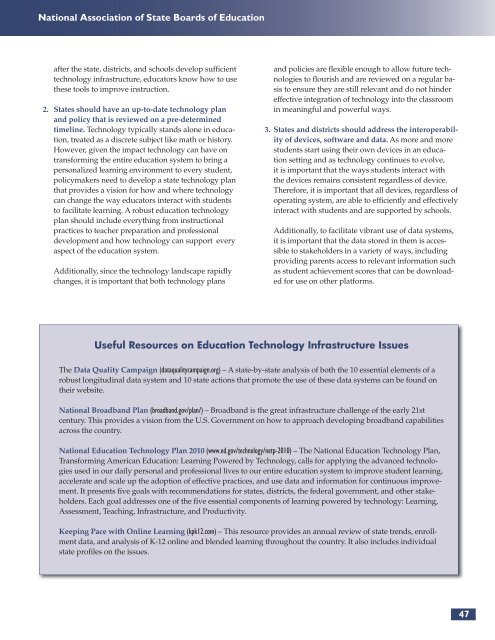You also want an ePaper? Increase the reach of your titles
YUMPU automatically turns print PDFs into web optimized ePapers that Google loves.
National Association of State Boards of Education<br />
after the state, districts, and schools develop suffi cient<br />
technology infrastructure, educators know how to use<br />
these tools to improve instruction.<br />
2. States should have an up-to-date technology plan<br />
and policy that is reviewed on a pre-determined<br />
timeline. Technology typically stands alone in education,<br />
treated as a discrete subject like math or history.<br />
However, given the impact technology can have on<br />
transforming the entire education system to bring a<br />
personalized learning environment to every student,<br />
policymakers need to develop a state technology plan<br />
that provides a vision for how and where technology<br />
can change the way educators interact with students<br />
to facilitate learning. A robust education technology<br />
plan should include everything from instructional<br />
practices to teacher preparation and professional<br />
development and how technology can support every<br />
aspect of the education system.<br />
Additionally, since the technology landscape rapidly<br />
changes, it is important that both technology plans<br />
and policies are fl exible enough to allow future technologies<br />
to fl ourish and are reviewed on a regular basis<br />
to ensure they are still relevant and do not hinder<br />
effective integration of technology into the classroom<br />
in meaningful and powerful ways.<br />
3. States and districts should address the interoperability<br />
of devices, software and data. As more and more<br />
students start using their own devices in an education<br />
setting and as technology continues to evolve,<br />
it is important that the ways students interact with<br />
the devices remains consistent regardless of device.<br />
Therefore, it is important that all devices, regardless of<br />
operating system, are able to effi ciently and effectively<br />
interact with students and are supported by schools.<br />
Additionally, to facilitate vibrant use of data systems,<br />
it is important that the data stored in them is accessible<br />
to stakeholders in a variety of ways, including<br />
providing parents access to relevant information such<br />
as student achievement scores that can be downloaded<br />
for use on other platforms.<br />
Useful Resources on Education Technology Infrastructure Issues<br />
The Data Quality Campaign (dataqualitycampaign.org) – A state-by-state analysis of both the 10 essential elements of a<br />
robust longitudinal data system and 10 state actions that promote the use of these data systems can be found on<br />
their website.<br />
National Broadband Plan (broadband.gov/plan/) – Broadband is the great infrastructure challenge of the early 21st<br />
century. This provides a vision from the U.S. Government on how to approach developing broadband capabilities<br />
across the country.<br />
National Education Technology Plan 2010 (www.ed.gov/technology/netp-2010) – The National Education Technology Plan,<br />
Transforming American Education: Learning Powered by Technology, calls for applying the advanced technologies<br />
used in our daily personal and professional lives to our entire education system to improve student learning,<br />
accelerate and scale up the adoption of effective practices, and use data and information for continuous improvement.<br />
It presents fi ve goals with recommendations for states, districts, the federal government, and other stakeholders.<br />
Each goal addresses one of the fi ve essential components of learning powered by technology: Learning,<br />
Assessment, Teaching, Infrastructure, and Productivity.<br />
Keeping Pace with Online Learning (kpk12.com) – This resource provides an annual review of state trends, enrollment<br />
data, and analysis of K-12 online and blended learning throughout the country. It also includes individual<br />
state profi les on the issues.<br />
47


